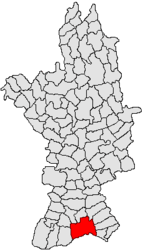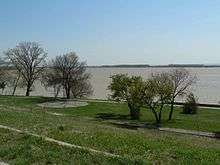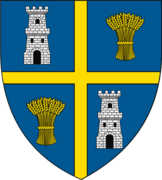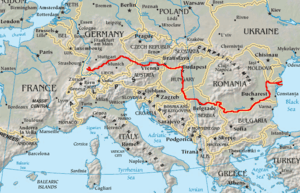Corabia
Corabia (Romanian pronunciation: [koˈrabi.a]) is a small Danube port located in Olt County, Oltenia, Romania, which used to be part of the now-dissolved Romanaţi County before World War II. Across the Danube from Corabia lies the Bulgarian village of Gigen.
Corabia | |
|---|---|
 Coat of arms | |
 Location in Olt County | |
 Corabia Location in Romania | |
| Coordinates: 43°46′25″N 24°30′12″E | |
| Country | |
| County | Olt |
| Government | |
| • Mayor | Iulică Oane[1] (PSD) |
| Area | 123.19 km2 (47.56 sq mi) |
| Population (2011)[2] | 16,441 |
| • Density | 130/km2 (350/sq mi) |
| Time zone | EET/EEST (UTC+2/+3) |
| Vehicle reg. | OT |
| Website | www |
History
| Historical population | ||
|---|---|---|
| Year | Pop. | ±% |
| 1912 | 9,124 | — |
| 1930 | 8,857 | −2.9% |
| 1948 | 10,772 | +21.6% |
| 1956 | 11,502 | +6.8% |
| 1966 | 14,502 | +26.1% |
| 1977 | 19,705 | +35.9% |
| 1992 | 22,386 | +13.6% |
| 2002 | 21,932 | −2.0% |
| 2011 | 16,441 | −25.0% |
| Source: Census data | ||
Beneath Corabia, around the former village of Celei, lie the remains of Sucidava, an old Dacian and Roman town and fortress. Near the town, Emperor Constantine the Great built the longest European bridge over the Danube (2437 m). The bridge was destroyed during the Avar invasions, probably in the 7th century. The ruins also contain an old Roman bath and an old basilica. The name Corabia reflects the fact that the new settlement was built from the remains of a wrecked Genoan ship (corabia is the Romanian language term for "sailing ship", specifically used for "galley"). It became a thriving port in the 1880s.
Under the communist regime, Corabia developed as a considerable manufacturing town, with a sugar mill, furniture factory, tannery, a fiber manufacturing plant, and various other facilities. However, in more recent times the town's population has dwindled. Many inhabitants have migrated to larger towns in the wake of the closure of many of Corabia's factories.
Geography
Corabia is still one of the central spots of Olt County; the town administers two villages, Tudor Vladimirescu and Vârtopu. The town houses a football club, several shops and bars, the remains of the Roman castrum Sucidava, dating back to the Roman period and featuring the "Secret Fountain" (an unusual piece of engineering); the Holy Trinity Orthodox Cathedral (one of the largest buildings of its kind in Romania), as well a monumental statue in the middle of the town square commemorating the use of Corabia's facilities in the initial attack during the Romanian War of Independence. Corabia also has an important archaeological museum with, inter alia, a remarkable collection of Roman pottery. From the town harbour one can make trips along the Danube, with stops at the nearby Băloi Island.
Natives
- Pavel Chihaia
- Theodor Danetti
- Nicolae Dobrescu
- Valentin Al. Georgescu
- Pola Illéry
- Șerban Ionescu
- Theodor D. Ionescu
- Virgil Mazilescu
- Ion Oblemenco
- Ion Rîmaru
- Robert Săceanu
- Vladimir Screciu
- Cristina Vărzaru
- Ștefan Voitec
Gallery
 Culture House and Archaeological Museum
Culture House and Archaeological Museum City center
City center Danube at Corabia
Danube at Corabia 1877 Independence War Heroes Monument
1877 Independence War Heroes Monument 1 May Street
1 May Street Sucidava's Secret Fountain
Sucidava's Secret Fountain Holy Trinity Cathedral
Holy Trinity Cathedral
References
- "Results of the 2016 local elections". Central Electoral Bureau. Retrieved 5 April 2020.
- "Populaţia stabilă pe judeţe, municipii, oraşe şi localităti componenete la RPL_2011" (in Romanian). National Institute of Statistics. Retrieved 4 February 2014.
| Wikimedia Commons has media related to Corabia. |

